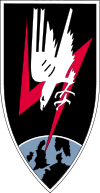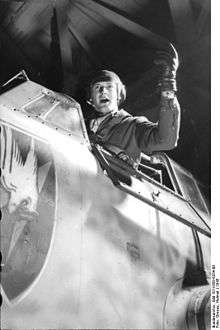''Nachtjagdgeschwader'' 1
| Nachtjagdgeschwader 1 | |
|---|---|
 | |
| Active | 22 June 1940 – 8 May 1945 |
| Country |
|
| Branch |
|
| Type | Night Fighter |
| Role | Air superiority |
| Size | Air Force Wing |
| Engagements | World War II |
| Aircraft flown | |
| Fighter |
Messerschmitt Bf 109 Messerschmitt Bf 110 Junkers Ju 88 Heinkel He 219 |
Nachtjagdgeschwader 1 (NJG 1) was a German Luftwaffe night fighter-wing of World War II. NJG 1 was formed on 22 June 1940 in Mönchengladbach. By the end of the war it was the most successful night fighter unit and had claimed some 2,311 victories by day and night, for some 676 aircrew killed in action.[1]
Operational history
The unit was formed in June 1940 from elements of Zerstörergeschwader 1 (ZG 1), Zerstörergeschwader 26 (ZG 26), JG 2, and Kampfgeschwader 30. In common with all other air forces of the time, the Luftwaffe did not possess an organized night fighter force at the outbreak of war. Although 5 Staffeln of Bf 109's and Bf 110's were designated as dual day/night fighter units, no specialist aircraft or trained crews existed and all night fighting took place on an ad-hoc basis by existing front line units.
By 1940 it was clear the Bf 110 twin engine fighter was more suitable for night defense duties, and in mid 1940 NJG 1 was formed from a cadre of experienced Zerstörer crews. Based at Deelen, the Netherlands, the unit were part of the 1st Night Fighter Division under Oberst Josef Kammhuber. With little technical equipment or training, interceptions of night flying RAF bombers were sporadic through the year, although by October the first Himmelbett zones were in place to aid the aircrews with radar guidance and radio assistance from the ground.
Stretching across the approaches to the vital industrial targets in the Ruhr, each 'Himmelbett' zone had a searchlight battery and two Würzburg radar, one of which linked the fighter to a ground control, and one to a master searchlight to illuminate the bombers. The plotting control room enabled the single night fighter manning each zone to be vectored towards the bombers. The system first became known as 'Helle nachtjagd' and was evolved in to 1941 to include the longer range Würzburg radars, the short range Freya, and a single NJG 1 night fighter allocated to each 30 mile square zone.

Simple though the interception system was, NJG 1 did obtain a certain degree of success in 1941. Many future Night Experten would learn their trade in these early days, such as Helmut Lent, who with 6./NJG 1 based at Leeuwarden in the Netherlands, claimed his first victory in March 1941. By the end of 1941 Lent (with 20 victories) and Werner Streib (22 victories) were the top scorers of NJG 1.
However, the need for an airborne radar interception system became increasingly obvious. The first Ju 88C fighters, equipped with Lichtenstein FuG 202 UHF-band airborne radar were delivered to I./NJG 1 at Venlo early in 1942. This allowed the crews to track a target over a range of 3,500 to 6,100 yards, the image appearing as a 'blip' on two cathode ray tubes.
NJG 1 also started receiving the upgraded Bf 110 G-4 in February 1942, able to be fitted with numerous 'conversion kits', giving the Geschwader flexibility in weapons, fuel capacity and engine performance. In 1942 the Dornier Do 217 J was also trialed in service with NJG 1; however the lack of performance made the type unpopular with crews.
1943
In early 1943 the heavy fighters of the Night Fighter Arm, NJG 1 among them, were also being used against the raids by the daylight bombers of the US 8th Air Force, where it was thought their heavier armament and longer endurance would complement the day fighters. However, most night fighter crews had little experience of day combat techniques, and the missions inevitably saw a steady attrition of these specialist crews.

By the start of 1943, almost all NJG 1's fighters were equipped with radar and the Nachtgeschwader were inflicting ever higher losses on RAF Bomber Command (Lent had claimed his 50th kill in January). The battle in the night skies became an ever more accelerated technological race between the RAF's need for accurate navigation and bombing aids and the Luftwaffe's requirement for tracking and location of the bomber streams.
Gradually, the old Himmelbett system was now becoming increasing saturated and with the RAF introducing 'Window' counter-measures in July 1943, new tactics were needed. Zahme Sau was a new tactic introduced in 1943. At the indication of a forthcoming raid, the fighters were scrambled and collected together to orbit one of several radio beacons throughout Germany, ready to be directed en masse into the bomber stream by R/T running commentaries from the Jagd division. Once fed into the stream, fighters made radar contact with a succession of individual bombers and maintained contact (and combat) as far as their ammunition and fuel held out.
Initial deliveries of the brand new Heinkel He 219 night fighter went to I./NJG 1 in mid 1943 for combat evaluation. Based at Venlo, I./NJG 1 was ultimately the only squadron to be equipped with the He 219, although a small number of aircraft were attached to other units, including NJG 3.
Bomber Command commenced its concentrated offensive against Berlin in November 1943, in what became known as The Battle of Berlin. NJG 1 was heavily involved in the increasingly effective night fighter riposte to the massed deep penetration raids and scored heavily up until late March 1944, when the RAF switched its attention to short range, tactical targets in preparation for Operation Overlord. The raids comprising the battle often took place in extremely poor weather conditions, and these conditions contributed to many of NJG 1's losses.
1944-45
Early 1944 also saw NJG 1's aircraft start to be equipped with the newer and more effective Lichtenstein SN-2 radar, further improving the unit's effectiveness. However, this period also saw the advent of anti-night fighter operations by Bomber Command's No. 100 Group RAF, and the commencement of radar-equipped de Havilland Mosquito fighter operations over Europe, leading to gradually increased losses among the overworked experienced Nachtgeschwader crews through 1944. By this time any flights, day or night, were hazardous, and NJG 1's Obfw. Heinz Vinke (54 kills) was shot down and killed by RAF Typhoons during a daylight air test on 26 February 1944.
Once the European invasion in June 1944 had stabilised and the Allied armies commenced an advance into France, the unit found their early warning radar network and monitoring infrastructure increasingly compromised, as more the Allies advanced. NJG 1 also suffered from undertrained crews, fuel and equipment shortages.
Commanding officers
- Oberst Wolfgang Falck, 26 June 1940 – 30 June 1943
- Oberst Werner Streib, 1 July 1943 – March 1944
- Oberstleutnant Hans-Joachim Jabs, March 1944 – May 1945
References
- ↑ 'History of the German Night Fighter Force', Gerhard Aders,1978 page 239.
Bibliography
- Hinchliffe, Peter (1998). Luftkrieg bei Nacht 1939–1945 [Air War at Night 1939–1945] (in German). Stuttgart, Germany: Motorbuch Verlag. ISBN 978-3-613-01861-7.
- Mauermann, Helmut."Fliegerhorst Störmede.Eine Chronik in Bild und Wort." 2005. ISBN 3-00-015708-5. (The base of III./NJG 1 Dec 1944 until March 1945)